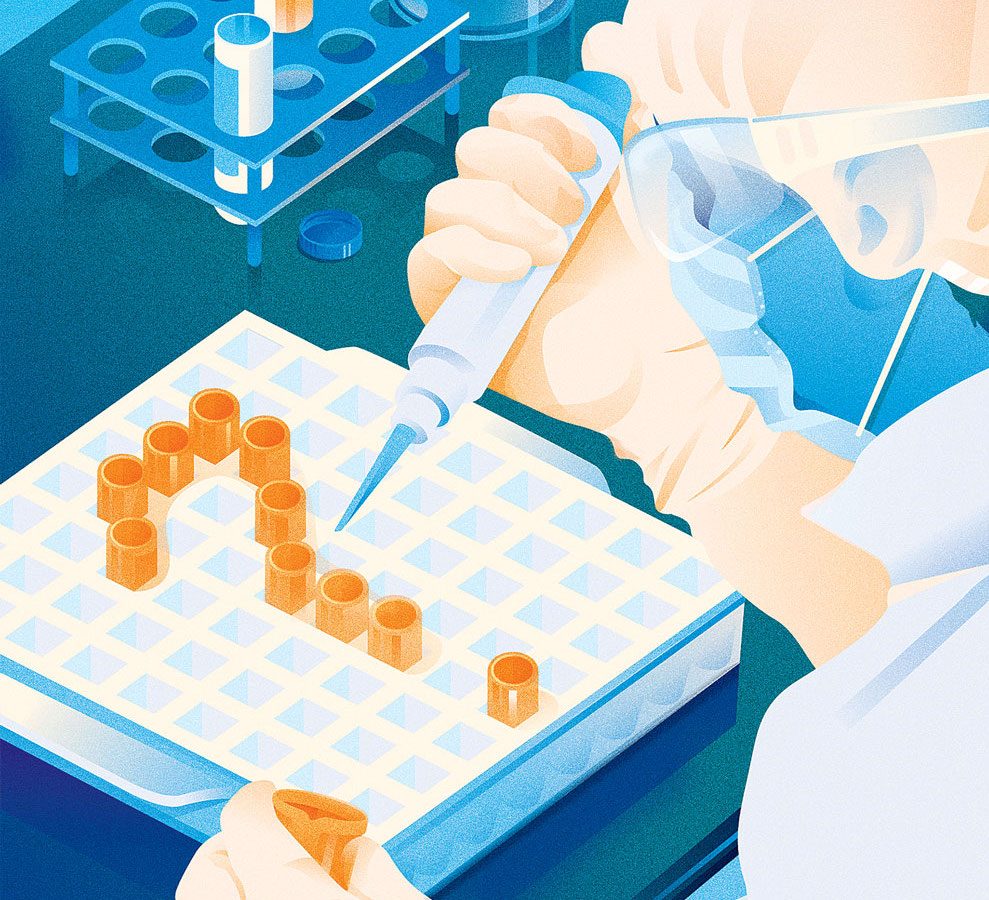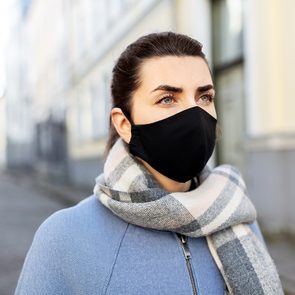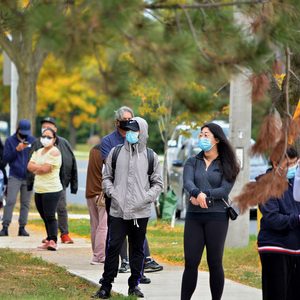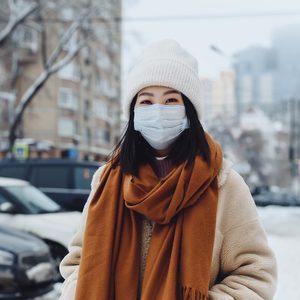The Making of a COVID-19 Vaccine
Canada’s scientists are racing to develop a COVID-19 vaccine. The next challenge: inoculate 7.8 billion people.

Our best shot
The sprawling Medicago facility in suburban Quebec City smells like a botanical garden and sounds like an airplane hangar. Thousands of Nicotiana benthamiana plants, a close cousin of tobacco, grow in long rows amid noisy ventilation. When the plants are six or seven weeks old and maybe 20 centimetres tall, they’re lined up by the dozens onto a flatbed that’s then inverted over a tank filled with fluid. The plants get dunked; the tank seals; and the leaves begin to absorb the liquid, made of a bacteria that’s been slightly tweaked. Bits of its DNA have been swapped out for DNA from the spike protein of SARS-CoV-2, the virus that causes COVID-19.
Once the plants come out of the tank, they’re moved to an incubation chamber. For the next week or so, the bacteria will insert its genetic information into the plants, triggering the production of millions of spike proteins in every cell of the infected leaves. The spikes self-assemble into something called a virus-like particle—not the virus itself but a particle roughly the size and shape of SARS-CoV-2. Gowned workers come and harvest the plants, stripping the leaves like they’re plucking basil for pesto, then send them to be shredded.
The chopped-up leaves head next into a vat of enzymes and are left to soak overnight. The enzymes work to break apart the cell walls, releasing the virus-like particles so they can be collected, purified and converted into a yellowish vaccine. This doppelgänger for SARS-CoV-2 can’t inflict any real damage. “But when you inject it into someone, the immune system sees it as though it’s the real virus and thinks, Oh my God, there’s an invader here,” says Medicago executive Nathalie Landry. “And then it will trigger a good immune response.”
A vaccine is, in essence, a trick—a sleight of hand that convinces your body to mount a counterattack to a given pathogen before that pathogen actually infects you. There are various ways to pull off the trick: vaccines can be made with a weakened virus, or a killed virus, or just a key part of the virus, or a part of the virus piggybacking on a different, benign virus, or the genetic instructions to make that key part of the virus yourself. In each approach, you get the benefits of an immune response without the messy business of a disease.
An effective vaccine is a crucial tool for combatting a virus impervious to borders, seasonality and many of the lockdown measures employed by anxious nations. But it’s not the pandemic finish line—it’s more like a pandemic off-ramp. Winding epidemiological, logistical and ethical roads still lie ahead: to determine how long and how well that vaccine’s protection can last, to manufacture enough of it to jab into billions of arms, to allocate the first batches of supply between countries and within their populations and to persuade vaccine skeptics to roll up a sleeve. Do that and we can protect the entire planet—all 7.8 billion of us.
Vaccine history
Humans have been trying to outsmart viruses for millennia. By the late 1600s, Chinese doctors were grinding a smallpox scab into a powder and blowing it up a healthy patient’s nose. An ambassador to Britain sent reports of 17th-century North African surgeons making a small incision between the thumb and forefinger, then squeezing smallpox pus into the wound. At the turn of the 19th century, Edward Jenner extracted fluid from a milkmaid’s cowpox blister and scratched it into the arm of an eight-year-old boy. These efforts may seem crude now—we prefer our vaccines packed tidily in glass vials and injected through sterile hypodermic needles—but the idea remains the same: teach the immune system how to ward off a virus so it has a head start should infection occur.
When a new pathogen invades the human body, our innate immune system recognizes the presence of something noxious and sends up an alarm. The first responders are proteins that meddle with a virus in order to limit its ability to reproduce. After that, the adaptive immune system kicks in: B cells (a type of white blood cell) begin making antibodies, the proteins that can subdue a virus by blocking its ability to get into the body’s cells. T cells (another type of white blood cell) arrive with two purposes: to help B cells make more antibodies and to assassinate cells the virus has already infected. It’s a more sophisticated response, but it’s also slower, taking a week, sometimes longer, to mobilize, which might not be soon enough to stop a virus from commandeering your body.
If the infection is cleared, many of the body’s B and T cells then die off themselves. Some, though, transform into memory cells, typically bunkered down in your bone marrow, where they wait to spring into action the next time that same pathogen attacks. “All it takes is one B cell to recognize the target and get activated, and it will start proliferating so it can produce the antibodies,” says Marc-André Langlois, a molecular virologist at the University of Ottawa. “That’s why vaccines work. They give you this life-saving element of having the antibodies ready to be deployed.” A defence that would otherwise take the body weeks to mount can be summoned in just a few hours.
The different types of vaccines
We’ve come a long way from smallpox pus, but to develop a vaccine, scientists still need to pick their poison. In modern medicine, that decision involves choosing whether to use the entire virus or just a vital part of it. Whole-virus vaccines take the pathogen—grown in giant batches of chicken eggs or in cells—and then kill it, usually with heat, chemicals or radiation. The upside is that the virus doesn’t cause disease once it’s introduced to the body, but it also doesn’t always cause a strong immune response, often requiring multiple doses. This approach is used in the flu shot and a hepatitis A vaccine, as well as in the one for polio, which a global vaccination effort has essentially wiped out.
In a more recent variation on the whole-virus vaccine, a pathogen is weakened in a lab rather than killed outright. Chances are you’ve been jabbed with a bunch of these vaccines: they’re how we fight measles, chicken pox, yellow fever and tuberculosis. Because the vaccine closely resembles a natural infection, it typically elicits a robust, enduring response. Because the vaccine is more potent, though, people with compromised immune systems are often unable to get it at all.
Another strategy is to block part of the virus rather than the whole thing. There are several ways of introducing this target protein—which is called the antigen—to the body. Most of them require another ingredient, usually aluminum, which for the past 90 years has been added to many vaccines to boost the immune response; aluminum stimulates our dendritic cells, which help trigger the adaptive immune system.
One way is to be directly injected with the pathogen’s critical protein, which triggers an antibody response. Virus-like-particle vaccines, such as Medicago’s plant-grown candidate, are a type of these protein-based vaccines. It’s a proven method—HPV and hepatitis B are just two examples—and there are usually few side effects once you’re given the shot.
Then there are genetic vaccines, which don’t deliver the antigen itself but instead issue a blueprint of that target protein to our bodies, hijacking our own cells to produce it. In a DNA vaccine, DNA containing the gene for the antigen is delivered to the cells. The cells copy those genetic instructions into molecules called messenger RNA (mRNA), which issue marching orders to the body to assemble the antigen. Messenger RNA vaccines skip the DNA entirely and deliver mRNA straight to the cells. The production time for such a vaccine can be cut down dramatically, which is why some researchers believe a genetic vaccine for COVID-19 will be ready first. But this is uncharted territory: no DNA or mRNA vaccines are currently approved for human use.
SARS-CoV-2 is a stealthy operator. It has a gift for binding to receptors on cells scattered in high numbers along the lining of our respiratory tract. When contact is made, it creates an opening through which the virus can pour its genetic code, the RNA, into our bodies. “The moment the RNA enters the body, it takes over the cell—there’s no wasting time,” says Natalia Martin Orozco, vice-president of drug development at Toronto’s Providence Therapeutics, which is working on an mRNA vaccine for COVID-19. The first proteins that SARS-CoV-2 produces are not to make more copies of itself but instead to suppress an immune response.
There are now more than 200 vaccine candidates for COVID-19 in development around the world, using every conceivable approach. Not all of these candidates, in the end, will work—many of them won’t. And it’s not yet clear what exactly will ward off this virus. Immunity isn’t an on/off switch: there are multiple levels of protection conferred by either shaking off a disease or receiving its vaccine. Some vaccines, like the one for hepatitis A, provide sterilizing immunity, which prevents the infection and its transmission almost entirely. Others, like those for diphtheria and tetanus, generate neutralizing immunity, where an infection can occur but won’t get very far and can’t make someone sick. Often protection isn’t lifelong, so we need booster shots to shore up our immunity.
When it comes to coronaviruses, immune responses tend to be short-lived: two to three years for the first SARS virus, for example, after which people exposed to that same pathogen would likely fall sick once again. Still, three years of protection sounds pretty good right now. As Martin Orozco says, “Even if the vaccine lasted just one season, that, to me, would be a really great accomplishment.” In the midst of a pandemic, a SARS-CoV-2 vaccine that performs as well as a flu shot is nothing to sneeze at.
Lessons from the flu
Twice a year, a consortium of scientists representing influenza centres in more than 100 countries descends on the World Health Organization (WHO) to pick the flu strains that should be combatted by seasonal vaccines. Once the recommendations are made, the viruses are produced in WHO laboratories, then shipped to the companies around the world that manufacture the corresponding vaccines. There is no centralized body whipping up batches of SARS-CoV-2 for developers looking to try their hand at a COVID-19 vaccine. Instead, they need the genetic code for the virus, which Chinese researchers sequenced in the second week of January and shared in a public database. Once scientists determined what was inside the 30,000 “letters” of this coronavirus’s RNA, they could decide which proteins to target in their vaccines.
After developers pick their antigen and their delivery system, they test it, starting with animals. Because ferrets and hamsters are, like us, naturally susceptible to SARS-CoV-2, they were a popular choice for early vaccine trials at the University of Saskatchewan’s Vaccine and Infectious Disease Organization-International Vaccine Centre (VIDO-InterVac).
If the vaccine protects those animals from infection, the next step is a safety trial with dozens of people to see if fevers spike or injected arms swell, followed by another trial, which measures the strength of the immune response that’s produced. Then it’s on to the third trial, where thousands of volunteers are monitored for a statistically significant difference between rates of infection in an unvaccinated control group and in people who actually got the jab. At least nine leading candidates have entered Phase 3 trials, including ones from the University of Oxford, Moderna and Pfizer. Currently, the WHO has set the minimum bar for an effective vaccine at an infection-reduction rate of 50 per cent, though 70 per cent is preferred.
What’s needed to make enough doses for these trials depends on the type of vaccine. For Medicago’s plant-based candidate, there must be well-stocked greenhouses and a dunking tank. To take another example: at VIDO-InterVac, where researchers are working on a protein-based vaccine, they begin with a single cell. “We take the gene from the virus that encodes for the spike protein and we put that gene into the single cell, which now thinks it is its own protein,” says VIDO-InterVac director and CEO Volker Gerdts.
At first, scientists use a flask that contains everything necessary to make a cell happy—some sugars, a couple of amino acids, a nice, warm environment and a little CO2—so the cell is fooled into believing it’s still in a body. One cell divides into two, then four, then eight, then 16; the flask becomes a three-litre beaker, the three-litre beaker becomes 20 litres, then 250, all the way up to a 1,000- or 2,000-litre bioreactor. From one individual cell you can make enough of the protein for thousands, even millions, of doses.
Making a successful vaccine is one challenge. Making enough of it to satisfy world demand is another. Every facility needs to conform to Good Manufacturing Practices (GMP), which are exceptionally specific rules set out by the WHO that ensure quality control. You want consistency over time so that each successive batch is the same.
Many Canadian labs can produce enough vaccine for their clinical research under these strict GMP conditions. But when it comes to scaling up production, we’re not in nearly as strong a position. There are two facilities in Canada with large-scale production capacity: the National Research Council, which partnered with CanSino Biologics to produce its vaccine and received a recent $126-million boost from the federal government; and Medicago, which signed a contract to supply the federal government with 76 million doses of its in-development vaccine, which if clinical trials go well could be ready for distribution to the public in the first half of 2021.
A third facility is slated to be built in Quebec, with greenhouses the size of two football fields, though that won’t be completed until 2023. And, in March, VIDO-InterVac received $23.3 million from the federal and provincial governments, half of which will be used to complete its own much larger facility, which should be ready by July 2022.
In the meantime, Canada has turned elsewhere for treatments. In early August, Procurement Minister Anita Anand announced the first of a pair of deals with American companies Pfizer and Moderna for tens of millions of doses of their vaccines. By October, Canada had made arrangements with four additional companies, committing a total of more than $1 billion for nearly 200 million potential doses.
Plenty of other countries inked deals of their own this summer. By mid-August, preorders of COVID-19 vaccine candidates were reportedly stretching toward six billion doses, the majority claimed by wealthy nations. But every country and company will be competing for the same limited supplies. Already there have been murmurings of glass shortages that could curb the availability of vials; stoppers are made by only a handful of companies. It doesn’t take much to cause a major bottleneck.
What happens after we have a vaccine?
We might be inventing a vaccine from scratch, but we’re not inventing a whole new system to get it into the arms of Canadians. When it comes to distributing vaccines for COVID-19, Canada will most likely take cues from the influenza-vaccination programs we have in place now. For those, Health Canada approves and then bulk orders the vaccines, choosing a couple of different candidates in case there are manufacturing snafus.
The provinces then determine how exactly to get the doses out, allotting a certain share to family doctors, public health clinics, community clinics and pharmacies. Typically they’ll also decide whether they will publicly fund vaccination and for whom. Ontario has a universal flu-vaccination program, for example, and British Columbia and Quebec do not, though it’s hard to imagine that anyone will have to shell out for a COVID-19 shot.
While flu shots are ordered and distributed based on how many people got one the previous year, planning for COVID-19 vaccines presents its own challenges: we don’t know what the supply is going to be, how well it will work in different populations or how many doses the vaccine might require. In fact, administering the flu shot this influenza season will be a good trial run for getting out a COVID-19 vaccine. Although physical-distancing measures and travel restrictions might mean a milder flu season, health-care officials in Canada are anticipating higher demand this winter. Expect longer hours, assigned appointments and perhaps even at-home vaccinations, especially for high-risk or vulnerable people.
The National Advisory Committee on Immunization (NACI), formed back in 1964 to review administering the polio vaccine, among others, makes recommendations on immunization practices and schedules, including which populations (often front-line workers and the elderly) should get the vaccine first.
NACI advises on priorities, but because health care is a provincial responsibility, it’s up to the provinces and territories to actually implement those recommendations. And it’s the provinces that actually set most of the disease-control goals. Do you vaccinate to prevent mortality? In that case, for this virus, the elderly need to be prioritized. Do you vaccinate to reduce transmission and spread? There are some house-partying twentysomethings in Kelowna who could get the jab. Or do you vaccinate widely in an attempt to achieve herd immunity?
We know, when it comes to COVID-19, that racialized and low-income people are infected at rates wildly disproportionate to their populations, not for any epidemiological reason but because of historical and economic disadvantages. This inequality persists for those employed in the health-care system itself: according to a study of almost 100,000 health-care workers in the U.S. and U.K. published in The Lancet, racialized workers were nearly twice as likely as their white colleagues to come down with COVID-19. Perhaps decision making about vaccine prioritization should be based on structural social causes instead.
It’s been a year since the virus arrived, and in that time, a few hundred vaccine candidates have been created, dozens have entered human trials and pretty much every promising new technology has been pressed into action. Work that would normally occur in sequence and stall on some bureaucrat’s desk is now, thanks to huge financial investments by governments around the world, happening swiftly and in tandem. That still won’t buy an end to this pandemic as quickly as we’d like: there’s much mask-wearing and social distancing and staying home ahead. But the average new vaccine takes about a decade to make it to market. The fastest ever to make it to market, for mumps, arrived in four years. We’re virtually guaranteed to shatter that record for COVID-19—one more unprecedented event in an era already full of them.
© 2020, Danielle Groen. From “How to Vaccinate a Planet,” from The Walrus (September 15, 2020).
Next, here’s what Canadians need to know about the new COVID-19 vaccines.






